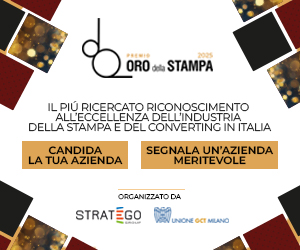ROTOGRAVURE AND LAMINATION Bobst organized at Casale Monferrato an open house to show the technological advances capable of improving the productivity and quality of printing and converting processes.
On the Bobst map, the seat of the former Rotomec functions, as is known, as a center of corporate excellence for rotogravure printing, spreading and lamination, where machines are designed and built and sent to users across the globe. Last October, the Piedmontese facility opened its doors in order to present the latest developments in the group’s research to representatives of user concerns (150 were invited from 15 different countries), who were welcomed by the Swiss group’s Italian managers, the directors of its sheet-fed, web-fed and services business unit and designers and marketing managers from throughout the group’s network. The event was lively, and participation was the rule, and all on the backdrop of a successful re-organization carried out during the past few years with the goal of consolidating the group’s global leadership, as shown by the positive 2011 final balance.

Solvent and solventless – The event featured a solventless lamination demo using a Bobst SL 1000 and one with solvent using a Bobst CL850D with flexo spreading system.
The Bobst SL 1000 laminated a 20 micron metalized BOPP film onto a 20 micron BOPP that had been pre-printed (flexo) using a BOBST F&K, at a speed that quickly and exponentially accelerates from an initial 50 m/min to a max production speed of 400 m/min. Versatile and customizable in terms of shaft or shaftless unwinders and reel diameter, this machine features ample flexibility of configuration. On the demo model, the lamination unit was positioned after the bridge, before the rewinder.
The second stop on the tour, in the Technology Center, showed the hi-tech duplex lamination machine Bobst CL 850D, which showed off the reliability and quality of its performance, and the advantages of the flexo trolley with which it was equipped for the occasion. The trolley in question is used mostly for spreading where solvent adhesives are applied directly onto thin aluminium, and the demo illustrated the efficiency of the technology and the quality of this product, with a more evenly spread adhesive on the aluminium, in such a way rendering a superior visual impact on the lamination. The CL 850D spread adhesive directly onto the 6.35 micron aluminium, then laminated it with a 12 micron PET, obtaining a flawless product at 430 m/min.
Advances in rotogravure – A live demonstration was also dedicated to an imposing Rotomec 4003HS (high speed) rotogravure printing line with shaftless cylinders. The many reasons for excitement included the quality of the texts, codes and graphic elements reproduced on film at 500 m/min, the effectiveness of the TAPS (Total Automatic pre-Register Setting) system and the convenience of the new Twin Trolleys used for quickly mounting and extracting the cylinders and/or ink tanks on the various color units.
The Rotomec 4003HS shown in operation, with 650 mm print development, presented a new configuration with print cylinder cone block and printed a six color graphic on 12 micron PET film food packaging. When the machine was ready, an operator pressed the TAPS button, which started the rotary, positioned all register cylinders and automatically set the register control for each color, before initiating production. The entire process took less than 5 minutes, generating approximately 100 m of waste material; the visitors were able to follow along step by step on a display screen to verify the precision of the system during the acceleration ramps.
Dedicated to short runs – The same quality, performance and ease of use were demonstrated by the print test conducted on film with the Rotomec MW 80 (Mnimized Waste): this Bobst rotogravure printer for short runs, characterized by an original design that is striking in its extreme compactness (the conveyor belt’s path is cut in half), total accessibility from the floor and the steeply inclined drying hoods. In this case, the designers did not focus on speed (500 meters is impossible in processes that can last just 10 minutes) but for the quality of the cycles, which, in order to guarantee the necessary marginality, need first of all to minimize the time needed for each step and the waste material generated (in the demo, the 4+2 color process was completed in minutes and with just 73 meters of waste).
The subject of this test was a cosmetics packaging (pouches) printed in 6 colors on 20 micron BOPP film. In order to show how easy and quick preparation is for operating this rotary with no trolleys or cover, the operator performed the entire procedure with a single printing unit, including cylinder changeover, which requires no tools. The demo Rotomec MW 80 was equipped with light cylinders, but it can also use conventional shaftless cylinders and light sleeves.
Once the pre-register sequence was complete, the Rotomec MW 80 quickly accelerated, and in just 30 seconds it reached a maximum speed of 250 m/min, concluding the demonstration with an automatic changeover of the rewinder at full speed.
The value of a trolley At Casale, Bobst also presented Twin Trolley: an extremely flexible trolley of new conception that enables separating the rotogravure cylinder from the color ink outside of the machine. The two cylinders can thus be removed individually or together, in storage or on different printing units, all the while keeping the quadrichromy color inks on board, regardless of changing position required by the different tasks.
All characteristics of Twin Trolley are aimed at reducing waste of ink and solvent (up to 50%) and speeding changeover: the possibility of using 50 liter ink tanks (enough for long runs, making it unnecessary to carry the ink in a special reservoir, thus also carrying savings in washing times); the adoption of a three-way valve that enables separate discharge of dirty solvent during the pre-wash phase; the pre-wash system is designed for easy cleaning of the print cylinders directly on the machine.















